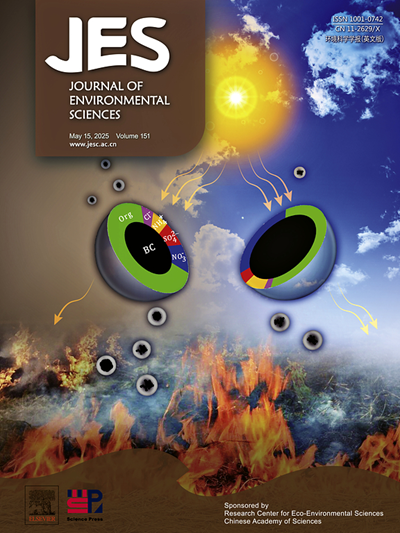利用含氟铜碳颗粒电极填充的三维电催化反应器降解2,4,6-三氯苯酚的研究
IF 5.9
2区 环境科学与生态学
Q1 ENVIRONMENTAL SCIENCES
引用次数: 0
摘要
三维颗粒电极系统在废水处理中显示出巨大的应用潜力。尽管如此,以提高催化活性和降低能耗为特征的有效颗粒电极的进步仍然是一个重大挑战。本研究以颗粒活性炭为载体,以掺氟改性氧化铜为催化剂,通过浸渍-煅烧技术,有效地合成了含氟铜碳(F/Cu-GAC)颗粒电极。随后利用颗粒电极在三维电催化反应器(3DER)中促进2,4,6-三氯苯酚(2,4,6- tcp)的降解。F/Cu-GAC颗粒电极在电场作用下发生极化,促进了O2双电子氧还原反应(2e-ORR)生成的H2O2催化分解为•OH的非均相类芬顿反应。配备F/Cu-GAC颗粒电极的3DER在运行2 h后,2,4,6- tcp去除率为100%,TOC去除率为79.24%,比能耗(EC)约为0.019 kWh/g·COD。通过线性扫描伏安法(LSV)和循环伏安法(CV)评估,F/Cu-GAC颗粒电极的过电位为0.38 V,电化学活性表面积(ECSA)为715 cm²。这些发现表明了高水平的电催化性能。此外,通过x射线光电子能谱(XPS)、电子自旋共振(ESR)和活性物质捕获实验,阐明了F/Cu-GAC粒子电极对3DER的催化机理。这项研究为2,4,6- tcp的有效降解提供了一种新的方法。本文章由计算机程序翻译,如有差异,请以英文原文为准。

Investigation into the degradation of 2,4,6-trichlorophenol utilizing a three-dimensional electrocatalytic reactor filled with fluorine-doped copper-carbon particle electrodes
The three-dimensional particle electrode system exhibits significant potential for application in the treatment of wastewater. Nonetheless, the advancement of effective granular electrodes characterized by elevated catalytic activity and minimal energy consumption continues to pose a significant challenge. In this research, Fluorine-doped copper-carbon (F/Cu-GAC) particle electrodes were effectively synthesized through an impregnation-calcination technique, utilizing granular activated carbon as the carrier and fluorine-doped modified copper oxides as the catalytic agents. The particle electrodes were subsequently utilized to promote the degradation of 2,4,6-trichlorophenol (2,4,6-TCP) in a three-dimensional electrocatalytic reactor (3DER). The F/Cu-GAC particle electrodes were polarized under the action of electric field, which promoted the heterogeneous Fenton-like reaction in which H2O2 generated by two-electron oxygen reduction reaction (2e-ORR) of O2 was catalytically decomposed to •OH. The 3DER equipped with F/Cu-GAC particle electrodes showed 100% removal of 2,4,6-TCP and 79.24% removal of TOC with a specific energy consumption (EC) of approximately 0.019 kWh/g·COD after 2 h of operation. The F/Cu-GAC particle electrodes exhibited an overpotential of 0.38 V and an electrochemically active surface area (ECSA) of 715 cm², as determined through linear sweep voltammetry (LSV) and cyclic voltammetry (CV) assessments. These findings suggest a high level of electrocatalytic performance. Furthermore, the catalytic mechanism of the 3DER equipped with F/Cu-GAC particle electrodes was elucidated through the application of X-ray photoelectron spectroscopy (XPS), electron spin resonance (ESR), and active species capture experiments. This investigation offers a novel approach for the effective degradation of 2,4,6-TCP.
求助全文
通过发布文献求助,成功后即可免费获取论文全文。
去求助
来源期刊

Journal of Environmental Sciences-china
环境科学-环境科学
CiteScore
13.70
自引率
0.00%
发文量
6354
审稿时长
2.6 months
期刊介绍:
The Journal of Environmental Sciences is an international journal started in 1989. The journal is devoted to publish original, peer-reviewed research papers on main aspects of environmental sciences, such as environmental chemistry, environmental biology, ecology, geosciences and environmental physics. Appropriate subjects include basic and applied research on atmospheric, terrestrial and aquatic environments, pollution control and abatement technology, conservation of natural resources, environmental health and toxicology. Announcements of international environmental science meetings and other recent information are also included.
 求助内容:
求助内容: 应助结果提醒方式:
应助结果提醒方式:


